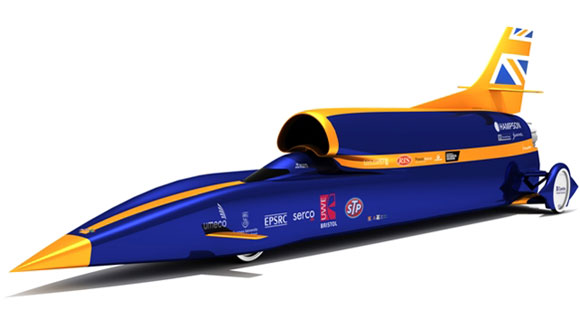Bloodhound SSC team successfully test 1,000mph land speed car’s rocket

A British team building a car capable of driving at land speed world record-breaking speeds today successfully tested the vehicle's rocket engine inside a shelter at Newquay Airport in Cornwall.
The event marked the most important milestone yet in the development of the 1,000mph Bloodhound SSC vehicle ahead of the team's attempt at the land speed record in two years' time.
Capable of producing 27,000lbf of peak thrust (122kN), at four meters (12 feet) long, 45.7 cm (18 inches) in diameter and weighing 400 kg, the Falcon rocket is the largest hybrid ever designed in Europe and the largest rocket to have been tested in the UK for 20 years.
CGI simulation of the Bloodhound SSC in action
In its final form it will generate thrust equivalent to the combined output of 95 Formula 1 cars.
The rocket was put through its paces at the airport in front of an audience of 400 people, and streamed live on the Guinnessworldrecords.com.
After surveying the sensor data, the rocket's designer Daniel Jubb said he was satisfied with the way the experiment had gone.
The rocket was operated for 20 seconds, producing the equivalent of 20,000-30,000 break horse power during the burn - just under half what it is set to produce during the record attempt.
During the test, the F1 engine revved up to 17,500rpm in order to fire HTP into the rocket at a pressure of 600lbs per square inch, equivalent to holding a large family car on the palm of your hand, and with enough flow to fill a bath in 5 seconds.
Sound levels during the test approached 185dB, many times that of a Boeing 747 at take off.
The rocket will not be the only power unit in the Bloodhound vehicle when it tries to break the world land speed record on a dried-up lakebed in South Africa.
There will also be a jet from a Eurofighter-Typhoon and Cosworth CA2010 engine usually found in Formula One cars.
The current land speed world record stands at 763.035 mi/h (1,227.985 km/h) (Mach 1.020), set in October 1997 by many of the key members of the same British team involved in the Bloodhound project, including project director Richard Noble, chief aero engineer Ron Ayres and driver, RAF Pilot Andy Green.
The test was conducted inside a Hardened Air Shelter (HAS) which was used in the past to house Tornado fighter-bombers, with the rocket being bolted to a stand so it could not move.


